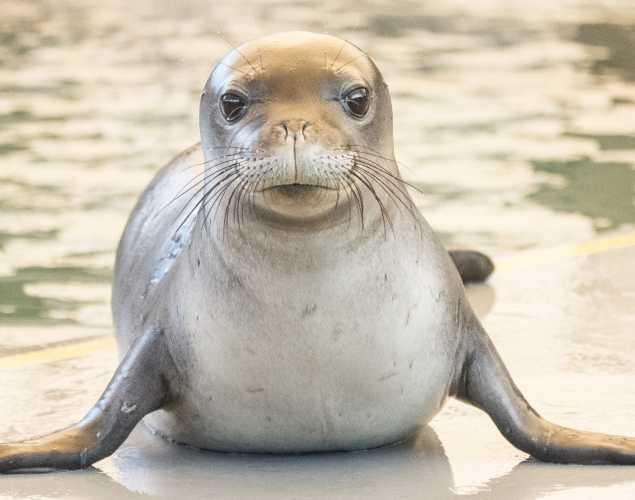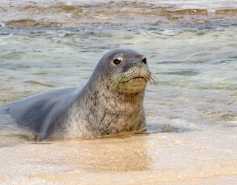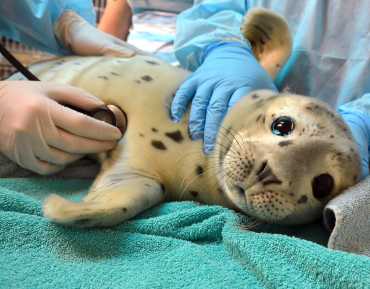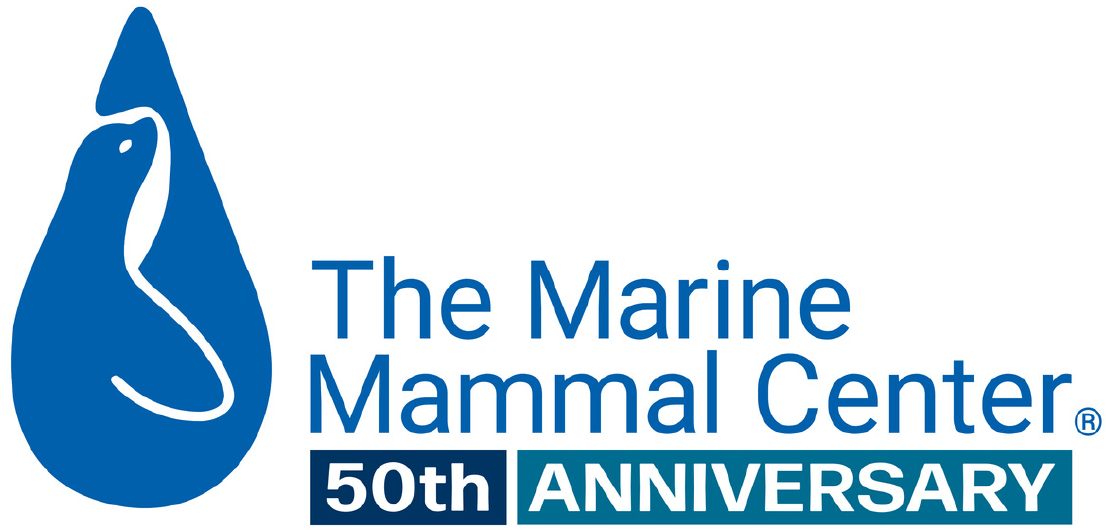
Say Aloha to `Awapuhi and Mililani
- Malnutrition
- Species conservation
As four healthy monk seals are released in the Northwestern Hawaiian Islands, two more patients are brought back to Ke Kai Ola for long-term care.
Two endangered Hawaiian monk seals were recently transported by NOAA researchers from the Northwestern Hawaiian Islands and brought to The Marine Mammal Center’s monk seal hospital, Ke Kai Ola, where they will receive rehabilitative care.
Both animals, a female pup named `Awapuhi and a three-year-old female named Mililani, are suffering from malnutrition, so our animal care experts are focused on getting them the nutritious fish meals they need to grow strong and healthy.
Our veterinarians say `Awapuhi was weaned too early and almost certainly would not have survived without help due to her small size and young age. Mililani is also much too small for her age—although she is three years old, she is about the size of a one- or two-year-old animal, and she’s so skinny that the outlines of her ribs and shoulder blades are visible.
The good news is that both animals have shown improvement since arriving at Ke Kai Ola. After being tube-fed a fish smoothie formula for several weeks, `Awapuhi is transitioning to eating whole fish, an important sign of progress for a young pup. Mililani has also been eating well—in fact, after receiving a de-worming treatment to remove her parasites, she has gained almost 20 pounds in the last week!
Meet Our Current Patients:
Ke Kai Ola Manager Deb Wickham accompanied the NOAA research vessel Oscar Elton Sette on its journey from the Main Hawaiian Islands out to the Northwestern Hawaiian Islands, a 1,200-mile archipelago of small islands and atolls that is home to about 1,100 endangered Hawaiian monk seals, nearly 80 percent of the entire population.
In addition to helping care for the two incoming patients, Wickham was able to witness the release of our four most recent Ke Kai Ola patients: male pup Niho`ole, female pup Lele-aka, female yearling Ha`aheo and five-year-old Mea Ola, the oldest monk seal we’ve rehabilitated to date. Wickham says they all seemed at home on the sandy atolls.
“Ha`aheo explored her surroundings, splashing and digging in the sand, and was even blowing bubbles! She seemed quite at ease on the island where she came from,” Wickham says. “When Mea Ola was released nearby, they touched noses and started rolling around together.”
When Wickham and the NOAA researchers returned to the Main Hawaiian Islands, they had another heartwarming story to share: The team had spotted a healthy Maka`ala, one of Ke Kai Ola’s first patients, at French Frigate Shoals. Maka`ala was one of four monk seals cared for at Ke Kai Ola before the Center even held its grand opening in 2014.
The resight is significant because it demonstrates the long-term impact of our work to save this species. Since opening the hospital three years ago, The Marine Mammal Center’s veterinary experts have successfully rehabilitated nearly two percent of this endangered population, returning 19 healthy monk seals to the wild with two more in our care now.
Researchers estimate the current monk seal population to be about 1,400 animals, and about 30 percent of those monk seals are alive today directly due to conservation efforts. Young seals are the most vulnerable animals in the population, with relatively few surviving to adulthood. Pups and juvenile seals in the Northwestern Hawaiian Islands often fall victim to threats like entanglement in ocean trash, changes in the food chain and predation.
Hawaiian monk seals are also highly sensitive to climate change impacts. Sea-level rise and increased coastal erosion will reduce the haul-out sites they depend on, and may increase shark predation. Increasing sea surface temperatures will limit available prey for marine mammals just as it has on the West Coast of the United States.
The two monk seals in our care right now are likely to stay at our facility in Kona for at least a few months while they gain strength before returning to the Northwestern Hawaiian Islands where they were rescued.
As these seals mature and have pups of their own, monk seal experts hope this will improve the species’ chances of survival in the islands that have been their home for millions of years.
The Marine Mammal Center's team also monitors Hawaiian monk seal haul out activity on the island of Hawaii and manages rescue efforts for sick and injured seals reported to the hospital’s hotline (808-987-0765).
Volunteer Opportunities on Hawaiʻi and Maui
Hawaiian monk seal conservation volunteers play an integral role in helping save this endangered species by monitoring and identifying seals that may require rescue and rehabilitation.
Volunteers also provide valuable public outreach to help raise awareness about the risks of human and pet interactions, and why this native animal is critical to the health of our shared ocean home.
The Center values volunteer engagement and inclusivity, and is proud to welcome existing and new volunteers into its ohana, or family, to create an even more robust and diverse community of volunteers.
Learn More About Hawaiian Monk Seals
Sign up to receive Hawaiian monk seal news, patient updates and more straight to your inbox.
{"image":"\/Animals\/Wild\/Hawaiian monk seal\/hawaiian-monk-seal-shutterstock.jpg","alt":"Hawaiian monk seal at the shoreline","label":"Pinnipeds","title":"Hawaiian Monk Seal","link_url":"\/animal-care\/learn-about-marine-mammals\/pinnipeds\/hawaiian-monk-seal","type":"page"}

{"image":"\/Animals\/Wild\/Hawaiian monk seal\/cropped-images\/HMS-wild-NOAA-4-832-3197-1474-1603733454.jpg","alt":"Two Hawaiian monk seals sleeping on the beach.","label":"Conservation","title":"Hawaiian Monk Seal Conservation","link_url":"\/science-conservation\/conservation\/hawaiian-monk-seal-conservation","type":"page"}

{"image":"\/Animals\/Patients\/Hawaiian monk seals\/2015\/hms-pearl-by-julie-steelman-c-the-marine-mammal-center-noaa-permit-18786.jpg","alt":"Hawaiian monk seal Pearl","title":"Understanding Endangered","link_url":"https:\/\/www.marinemammalcenter.org\/publications\/understanding-endangered","label":"Online Learning Resource","type":"publication"}

{"image":"\/Animals\/Patients\/Hawaiian monk seals\/2016\/hms-nihoole-5-photo-c-noaa-permit-16632.jpg","alt":"Hawaiian monk seal Niho'ole","title":"Aloha \u02bb\u0100ina","link_url":"https:\/\/www.marinemammalcenter.org\/publications\/aloha-aina","label":"Online Learning Resource","type":"publication"}

You Can Be a Hawaiian Monk Seal Hero
Thanks to our generous donors, young Hawaiian monk seals like `Awapuhi and Mililani are able to get a second chance at life in the wild. You can make a real difference for this endangered species and all of the marine mammals in our care by making a life-saving gift today.
Header image: photo by Laura Grote © The Marine Mammal Center / NOAA permit #18786
Yes, I want to save a life!

Yes, I want to save a life!
You’ll be giving sick and injured animals the best possible care at the Center’s state-of-the-art hospital. With your gift today, you are giving a patient a second chance at life in the wild.
See Our Latest News
{"image":"\/Animals\/Wild\/California sea lion\/cropped-images\/csl-release-4-5-24photo-by-chris-deimler-c-the-marine-mammal-center-138-0-1270-992-1745348188.jpg","alt":"Four young California sea lions walk on the beach toward the ocean.","title":"Achievements in Ocean Health","link_url":"https:\/\/www.marinemammalcenter.org\/news\/achievements-in-ocean-health","label":"News Update","date":"2025-04-23 10:20:00"}

{"image":"\/Misc\/Graphics\/cropped-images\/climate-change-graphic-giant-earth-shutterstock-1798-6-5113-3994-1680046432.jpg","alt":"An Earth Day graphic of people holding the planet, recycling, planting a tree and moving a solar panel.","title":"5 Ways to Celebrate Earth Day","link_url":"https:\/\/www.marinemammalcenter.org\/news\/5-ways-to-celebrate-earth-day","label":"News Update","date":"2025-04-18 11:21:08"}

{"image":"\/Animals\/Wild\/Sea otter\/cropped-images\/sea-otter-mom-pup-photo-c-brian-simuro-505-0-3387-2646-1618247266.jpg","alt":"sea otter mother and pup","title":"Meaningful Mother\u2019s Day Gifts for Ocean Lovers","link_url":"https:\/\/www.marinemammalcenter.org\/news\/eco-friendly-mothers-day-gifts-that-give-back","label":"News Update","date":"2025-04-10 02:00:00"}

{"image":"\/Animals\/Wild\/Harbor seal\/cropped-images\/harbor-seals-shutterstock-107-0-1270-992-1744225508.jpg","alt":"A group of harbor seal pups and mothers on the beach during pupping season.","title":"Your Guide to Seeing Harbor Seal Pups in California","link_url":"https:\/\/www.marinemammalcenter.org\/news\/your-guide-to-seeing-harbor-seal-pups-in-california","label":"News Update","date":"2025-04-10 00:00:00"}

species conservation
Hawaiian Monk Seal







